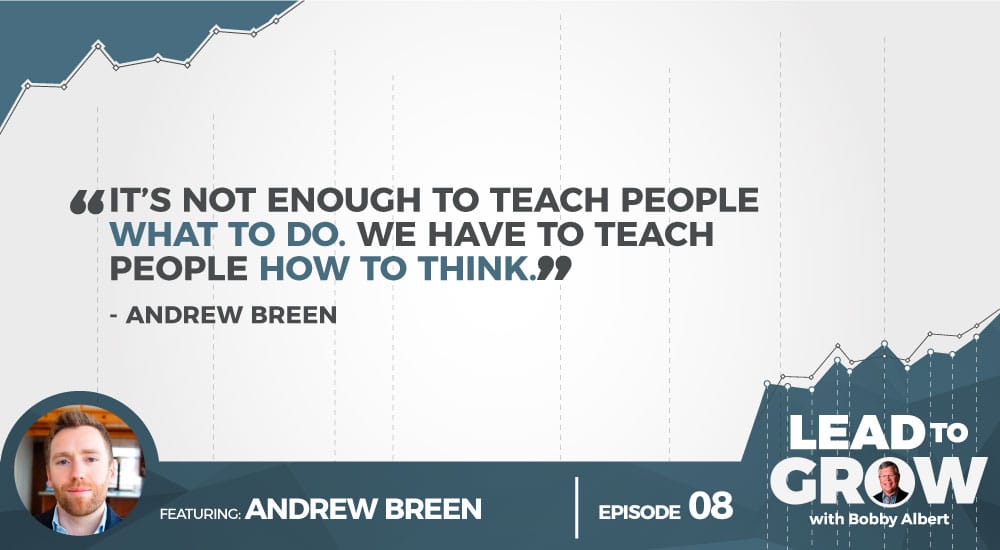Many leaders neglect true coaching and empowering. Often, leaders say they are giving employees their own freedom to learn in their own way. But without proper coaching, teaching, and understanding, employees often take up valuable time before making a healthy contribution to their employer.
Andrew Breen used to have a hands-off approach when it came to management. When he first co-founded Outshine almost a decade ago, he gave his employees very little direction. However, as his company started to grow, Andrew recognized a need for more management structure. He created a program that empowers employees with decision-making skills, not just methodologies and tactics.
The best news is, Andrew joined us on the Lead to Grow podcast and shared how his management philosophy totally changed his workforce, and added value to his company.
‘We Taught Ourselves, Others Will Do the Same’
Andrew started as an entrepreneur almost 10 years ago out of his bedroom doing SEO freelancing for larger companies. He was making good money, but he wasn’t building a business.
“Managers were causing roadblocks, and we just wanted to run wild and free.” — Andrew Breen
He realized that to create a true business, he would have to scale and bring on additional human capital. As he changed his business model and expanded, he thought, “I taught myself; others will have the same independent mindset.”
It’s easy to understand how he came to this conclusion. He was reacting to his own experiences in the workplace. “Management often felt as if they were an unnecessary layer of bureaucracy. In fact, they were holding back individual contributors from getting anything done. Managers were causing roadblocks, and many of us just wanted to run wild and free.”
Reacting, he and his partner had created a “playground for high-performers,” with a learn-along-the-way mentality. It didn’t work. Andrew kept running into the same problems over and over again with his staff. He was hiring highly qualified talent, but the performance was lagging.
It was time for a change.
They Started With One-on-Ones
After listening to a podcast episode (hint-hint), Outshine started with a simple strategy: host weekly one-on-ones with every employee. It had a dramatic impact on the learning curve of his employees.
Those continual 30-minute meetings became the basis of a more extensive management program. Those one-on-ones roll into quarterly meetings, which roll into annual meetings. For the quarterly and annual meetings, each employee receives 360-degree feedback.
They also invested heavily in onboarding and offboarding. These can be somewhat tedious processes, but Andrew utilized technology to alleviate the time lag.
The overhaul has had a tremendous impact: “We now pride ourselves on how we manage and lead. The change wasn’t easy, but it was well worth it.”
Teaching Your Employees How to Think
To Andrew, real management isn’t simply teaching how to do something, because in today’s world, methods often change in a matter of months. True management is educating others on how to think.
Many owners and managers believe teaching, or onboarding and offboarding, are too time-consuming.
Andrew believes the opposite.
He said prior to implementing their new system, it would take around six months for an employee to contribute something valuable for Outshine. Now, with his new coaching philosophy, reviews, one-on-ones, and proper onboarding, it only takes about three months.
Better management saved him time.
Empowering Decision-Making
Teaching others how to think has another unique advantage — you can then trust your employees to make the best decisions.
Outshine believes in a distinctly decentralized organization — they push all the authority and decision-making to the farthest edges of the company. They never want an employee to fear criticism or feel powerless to make their own decision.
Employees have captured this philosophy. They aren’t scared to step out and make choices when necessary. In turn, since leadership has instilled the company’s values into the employees, they feel comfortable allowing employees to think creatively.
Last Tip: Here’s What Andrew Looks for in a Potential Employee:
Before he left, we asked Andrew what he looks for in employees. Here’s what he said:
Andrew looks for someone who has truly mastered a specific talent and acquired all the skills necessary for a specialty. You can always move around later, but proving you have the sticktoitiveness for one talent shows your employer your character and willingness to create value.
This blog is based on a Lead to Grow podcast with guest Andrew Breen. (If you don’t use iTunes, you can find every episode here.)


